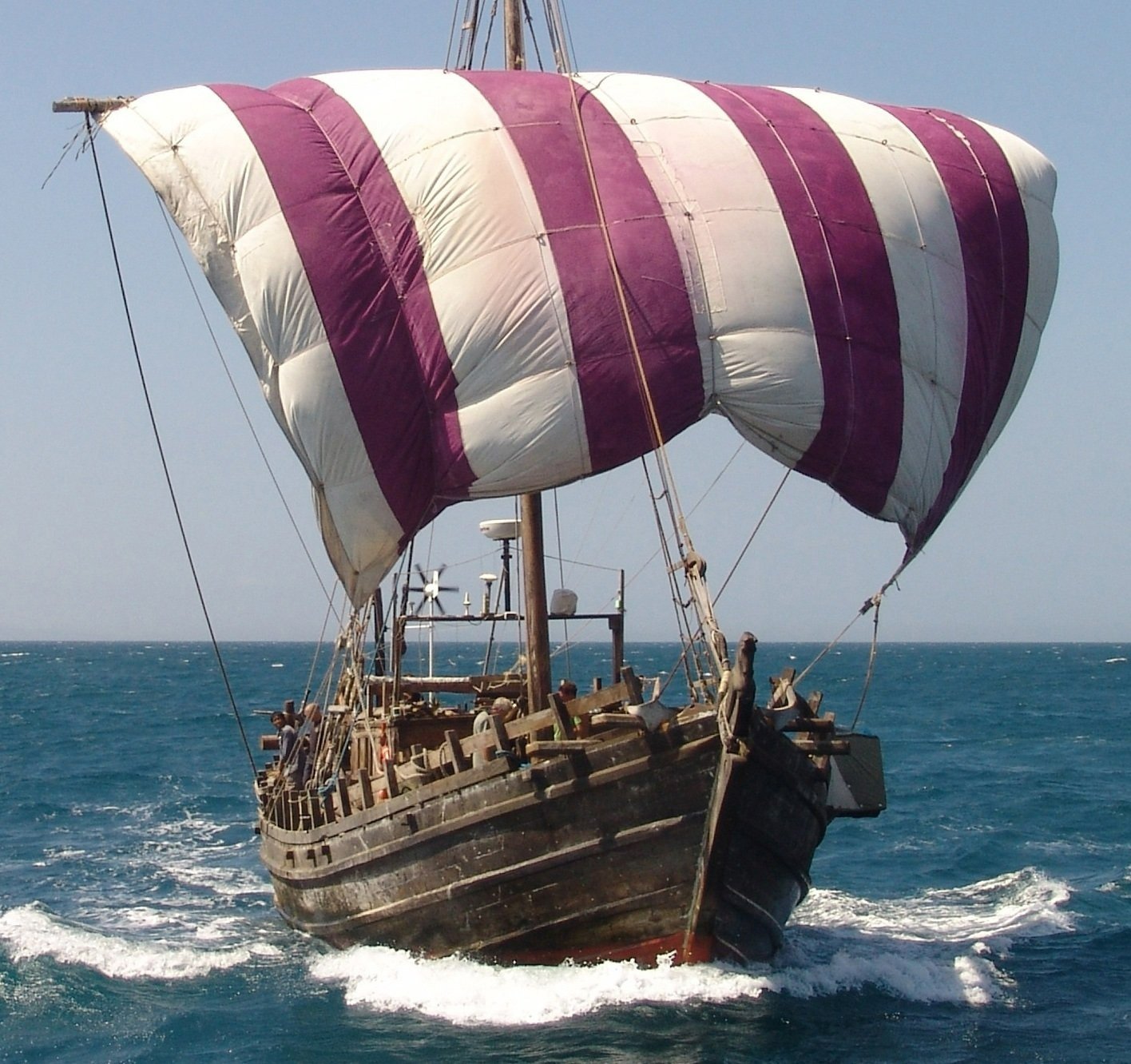
WHAT IS THE PHOENICIA?
Reconstructing the world’s oldest ship replica proving that the Phoenicians had the technology to cross the Atlantic 600 years before Christ.
PHOENICIA 600 BC REPLICA
The Phoenician Ship Expedition, led by Philip Beale, recreated a 6th Century BC Phoenician voyage using a replica ship. Departing from Syria in 2008, it sailed through the Suez Canal, around the Horn of Africa, along the west coast of Africa, through the Strait of Gibraltar, and across the Mediterranean before returning to Syria. In 2019, the ship sailed to America and landed in Florida. Both journeys demonstrated the seaworthiness of ancient Phoenician ships. The vessel, Phoenicia, modeled after the 2600-year-old Jules Verne 7 Shipwreck, sailed 30,000 miles, proving her seafaring capabilities. Due to circumstances, the ship requires reconstruction. The replica ship's components were shipped to Montrose, Iowa, where it is being reconstructed. (see more)
If you sign up for recurring payments, we will send you something special from our Phoenician Museum. Small monthly contributions of $10 have a significant and lasting impact on our work. Your support is invaluable in advancing our understanding of ancient American civilizations and the restoration of Phoenicia. Thank you for considering how you can contribute to our cause. For additional donation options, see the link below.
Construction workers in July 1993 discovered the wreck in the low oxygen mud of the ancient port of Marseille, France. Marseille is older than Rome. The city's history is a worthy showcase for the Jules Verne 7 Shipwreck, which is the source for the design of the 600 BC Phoenician replica in Montrose, Iowa.
LE MUSÉE D'HISTOIRE DE MARSEILLE has many artifacts and displays that cover the city's port from the 6th Century BC to the 4th Century AD. The museum's oldest shipwreck came out of the mud of the ancient port. The wreck goes back 2,600 years and provides the details for the reconstruction of the PHOENICIA. The original wreck is in the Old World, and her replica is in the New World. They are now connected, resulting in the rewriting of ancient history.
Construction workers in July 1993 were digging foundations in the port when they discovered one of Europe's oldest shipwrecks in the mud. The French put a great deal of time, money, and effort into the study and rescue of what they called Jules Verne Shipwreck 7. The remains of this 600 BC shipwreck are today on public display at the Musée d'Histoire de Marseille for you and others to see. The wreck goes back 2,600 years and provided Philip Beale with the details for his faithful construction of a replica ship that he called PHOENICIA. Captain Beale sailed his square-rigged replica ship 30,000 miles around Africa and across the Atlantic. Philip Beale raised two million dollars over 16 years, and he involved the efforts of nearly a hundred volunteers as crew members. In the Old World, there were 2,000 sponsors, including the British Museum. This was a very big story in Europe. It was on national television throughout North Africa, where 100 million viewers saw the ship. In February 2019, the Phoenicia arrived in Florida. Because of setbacks caused by COVID and a tropical storm, the ship replica, like her original, ended up in the mud. In 2021, a crane pulled the ship replica out of the mud from a canal in Fort Lauderdale. Captain Beale cut 40 tons of timbers and planks into sections. We bought half the cut pieces and moved them by truck to Iowa. The other half of the pieces we moved by water from England to Iowa. The original wreck remains in the Old World, and her replica is now in the New World. They are both connected, resulting in the rewriting of ancient American history.
Captain Philip Beale has earned the right to join the ranks of history’s great explorers. There is no other living person who has sailed as far as Philip on the world’s roughest seas in replica ships that were built according to patterns that are thousands of years old. Philip has traveled over 30,000 nautical miles on the world's oceans in square-rigged ships. No other person has done what he did, and having done it, Philip does not plan to do it again.
Click Video —->
The best minds of the PHOENICIA Restoration Team consulted with Captain Philip Beale about the fine points of joining the ship planks to the ribs of the hull.
The more we examine these details, the more amazed we are at what the shipwrights of the ancient world accomplished with the tools they had. To create a seafaring vessel that could cross the stormy seas of the Atlantic, each timber, each plank, and every joint had to be carefully put in its right place. Everyone considered it a great honor to be a part of such a restoration. America's ancient history will never be the same again.
TEAMWORK
PHOENICIA
WORKSHOP
The ship is in her current state of preservation thanks to the efforts of thousands of people and millions of dollars. Nearly all of that support came from the Old World. American volunteers donated 6,000 hours during the last two summers to restore the Phoenician ship replica. In the coming year, more volunteers and donors in the New World will support this project. We need to double our efforts to match what the Old World under the direction of Captain Beale has done in the last twenty years.
Phoenicia Gift Shop
Heartland Bus Tour
Thousands of People and Millions of Dollars
Captain Philip Beale has dedicated his life and fortune to the PHOENICIA. More than 200 research institutions, governments, and scientists have contributed to his experimental archaeology. Over a dozen countries sent 52 volunteers to rotate as crew members on the ship around Africa and across the Atlantic. Thousands of people and millions of dollars have been involved in the sailing of the PHOENICIA on two expeditions. As much as any other person, Captain Beale has shown the ancient connections between the Old and New Worlds.
The City of Carthage was one of the largest metropolises in the world at the time of 600 B.C. PHOENICIA. The city was a significant power in the ancient world that dominated the western Mediterranean. Heartland Research is happy that it works with Club Dion de Carthage in Tunisia.
We are so pleased that our friends in Carthage and Morocco offer to participate in establishing our Museum by bringing the history and tradition of their great civilizations. Welcome to America, where you can sing your songs, pray your prayers, dance your dances, and celebrate the trans-Atlantic crossing of your ancestors from the Old to the New Worlds.
ENTHUSIASTIC SUPPORTERS OF PHOENICIA AT FIRM FOUNDATION CONFERENCE, OCTOBER 2022
FRIENDS OF PHOENICIA GATHERED FOR GOOD FOOD AND GOOD COMPANY
VOLUNTEERS AT FIRM FOUNDATION EXPO SALT PALACE, OCTOBER 2022
BOOK OF MORMON CENTRAL AND HEARTLAND RESEARCH, SPRINGVILLE, UTAH, OCTOBER 2022
HEARTLAND RESEARCH PRESENTS TO FRANK MCALLISTER PHOENICIAN ARTIFACTS THAT TRAVELED 30,000 NAUTICAL MILES AROUND AFRICA AND ACROSS THE ATLANTIC.
Captain Philip Beale's Expeditions on World Map
Storms on the high seas can strike the ship’s hull with hundreds of tons of water, putting the ship at a high risk of breaking apart. The PHOENICIA is flexible and strong. 10,00 joints tie the planks to the keel and ribs. These joints give the ship her unique strength. The ship takes the force of the waves, stays upright, and keeps sailing. No other ancient ship had such a strong design
2,600 YEARS OF UNBROKEN CHRONOLOGY
PHOENICIA is the world's oldest replica ship that crossed the Atlantic. The 2,000 Years Before Columbus Expedition rewrote the history of America.
The Phoenicia was built using knowledge of construction techniques from discovered wrecks. The hull was made sturdy by using tenons to join planks together and then drilling holes and hammering pegs through the joints (pegged mortise-and-tenon joinery), after which the ribs of the ship were fit in.
Heartland Research is a non-profit and volunteer-driven organization that aims to connect the Bible to America in the 6th Century Before Christ.
The clearest artifact confirming this ancient connection is the Phoenicia Ship Replica in Monrose, Iowa.
So far, we have received over 6,000 hours of labor and thousands of donations, both large and small.
We need additional support to finish the project.
If you sign up for recurring payments, we will send you something special from our Phoenician Museum. Small monthly contributions of $10 have a significant and lasting impact on our work. Your support is invaluable in advancing our understanding of ancient American civilizations and the restoration of Phoenicia. Thank you for considering how you can contribute to our cause.
For additional donation options, see the link below.














































